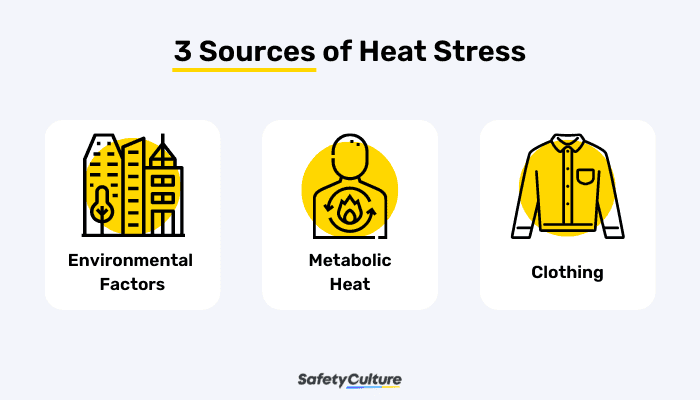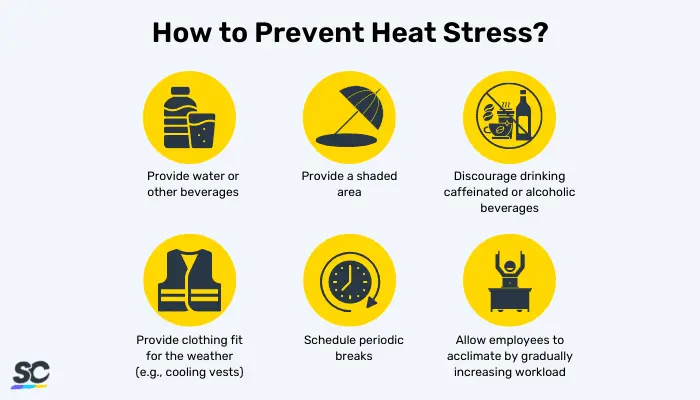What is Heat Stress?
Heat stress is the effect of heat load on a worker’s body from exposure to a combination of factors such as the environment, metabolic heat, and clothing. Heat stress causes the body to lose the ability to control heat and can lead to heat exhaustion and heat stroke.
What are The Causes of Heat Stress?
There are various causes of heat stress which can be categorized into 3 sources:

- Environmental factors – These are the high-temperature workplaces that can either be indoors or outdoors. Working in indoor areas such as bakeries, foundries, factories, and furnaces or in outdoor sites such as construction, road, mining, and agriculture can make the worker more susceptible to heat stress. Other environmental factors that can cause heat stress are weather or seasonal changes such as summer, as well as places with high humidity such as kitchens and laundries.
- Metabolic heat – This is the heat generated by a person’s body during physical activity. Metabolic heat is, in simple terms, internal heat. There are 3 ways the body can exchange heat with its surroundings, which are radiation, convection, and evaporation of sweat. Radiation is heat transfer from a source of heat, usually associated with the sun. Convection is the process wherein the body exchanges heat through the surrounding air. Lastly, the body cools itself through sweat evaporation. However, cooling through sweat is limited in areas with high humidity since the air can’t easily accept more moisture.
- Clothing – Employees should avoid wearing extra layers of clothing and clothing that absorbs heat. Their clothing should be made up of materials that can reflect heat and are appropriate for their workplace and tasks.
What are The Symptoms of Heat Stress?
People that have heat stress will commonly experience heat rash, muscle cramps, and severe thirst. Other symptoms include:
- Dizziness
- Headache
- Body ache
- Fatigue
- Rapid heartbeat
- Nausea
- Chest pain
- Labored breathing
If heat stress is left untreated, it can lead to illnesses such as heat exhaustion or heat stroke. The two heat-related illnesses have different symptoms, which are:
Heat Exhaustion
- Loss of body water and salt through excessive sweating
- Dizziness
- Muddled vision
- Fatigue
- Severe thirst
- Headache
- Nausea and vomiting
- Diarrhea
- Muscle cramps
- Labored breathing
- Palpitations
- Tingling and numbness of hands and feet
Heat Stroke (severe heat illness)
When heat exhaustion develops into heat stroke, call for medical help as soon as possible. What you can do: Move the worker to a cooler place, remove clothing, wet the person’s skin, apply cold wet cloths to the body, and anything to reduce the worker’s temperature before the ambulance arrives. The symptoms of heat stroke include:
- Body temperature greater than 41°C
- Complete or partial unconsciousness
- Confusion
- Hot, dry, or heavy sweating
- Seizures
How to Prevent Heat Stress?
Prevent heat stress in the workplace by ensuring that the environmental factors, metabolic heat (physical activity), and clothing are monitored. Here are some guidelines employers can adopt for their workers:

- Provide water or other beverages (preferably cold drinks).
- Provide a shaded area or a place that is cooler in temperature.
- Discourage workers from drinking caffeinated or alcoholic beverages during work hours.
- Prepare clothing fit for the weather and the type of work such as providing a hat or cooling gear.
- Schedule periodic breaks.
- Allow employees to acclimate by gradually increasing workload (metabolic heat) and heat exposure.
Create Your Own Heat Exposure Checklist
Eliminate manual tasks and streamline your operations.
Get started for FREEOccupational Heat Stress Requirements
To supplement existing requirements, OSHA is developing a new heat standard to include indoor workers who are not in climate controlled environments. OSHA highly suggests to keep the temperature between 68-78°F (20-25°C). Companies should have the initiative to develop plans to prevent heat stress and other illnesses due to hazardous heat conditions.
Keep Workers Safe from Heat-related Risks with Heat Stress Training
Working in hot and humid environments carries the risk of heat-related health issues like heat exhaustion and heat stroke. For this reason, it’s crucial to ensure that employees are able to perform their jobs as comfortably and safely as possible.
Besides providing necessary protective equipment, another effective way to achieve this is through comprehensive heat stress training. This will empower workers to recognize heat stress symptoms and warning signs, take immediate action, and promote healthy practices like hydration and rest breaks.
With Training, you can easily guide your team through managing heat stress at work. Its user-friendly drag-and-drop feature lets you create and launch visually appealing slides in just minutes, making it easier to reinforce heat stress prevention practices to workers across multiple sites.
How SafetyCulture (formerly iAuditor) Can Help to Protect Workers From Heat Stress
Employers can start their heat control programs by using digital tools and incorporating heat exposure checklists. The template can be used during heat stress toolbox talks, an essential tool most commonly used by the construction industry. All of these are possible with the leading health and safety app, SafetyCulture.
SafetyCulture features for heat control include:
- Alerts for Issues – Immediately get notified when a problem arises.
- Corrective Action – Workers can suggest corrective actions during an inspection.
- Data Insight – Check if there are repetitive issues which can help pinpoint root causes.



